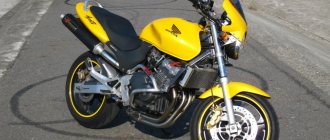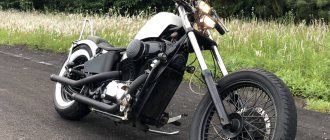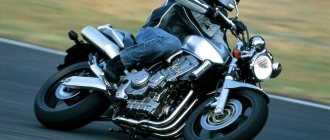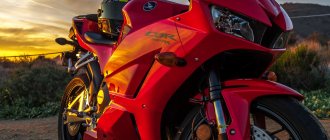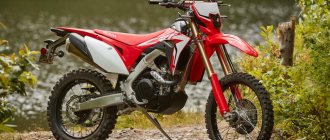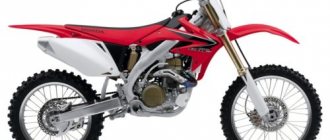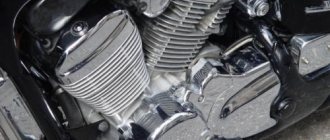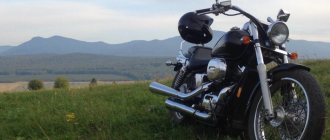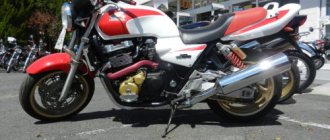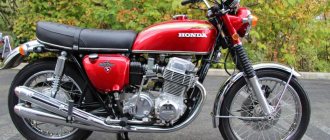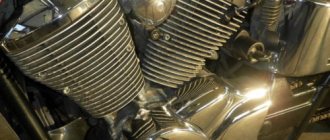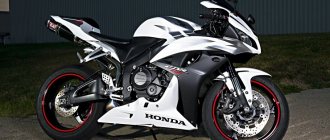The Honda CB600 road motorcycle was first talked about in 1998 . The model was produced for 14 years, production closed in 2012, but stocks were sold out on the market for another year. Starting in 2014, a successor, the cb 650, goes on sale.
Many considered the 600 to be the successor to the legendary four (HondaCB400), but the concept of the bikes was different. And the new product is based on a sports car model - cbr600, later CBR600RR.
Name confusion
Honda CB600 is a fast, light and moderately “evil” naked model that gained unprecedented popularity immediately after its debut back in 1998.
The Cb 600 became the "middle" sister in the Hornet line, which caused some confusion with the names. Found in various publications:
- Honda Hornet 600.
- Honda cb600f hornet.
- Honda cb 600.
- Honda cb 600 f.
But it was all one bike - the Honda Hornet 600. Only one modification , which is described below.
Review of the Honda CB 600 F Hornet motorcycle
An excellent BIKE for evening rides around the city. From the start it dynamically picks up maximum speed without crazy pickups, it is predictable, easy to steer, and would be suitable for a beginner. The suspensions do their job, but it’s better not to chase sportsbikes when cornering, as the stern wobbles. No progression. Suitable for travel, you just need a windbreaker and, of course, panniers. The volume of the gas tank is small - 16 liters, but this is enough for travelers in the city. The middle class Hornet 600 does not get boring. I will not repeat myself about the reliability of HONDA. Overall a cool motorcycle.
I left for the season in exactly the same one, only in silver. I agree that the motorcycle is rather boring in appearance (and in silver it looks dull), but it is practical to a fault. Comfortable seating position, good wind protection, quite peppy engine, predictable brakes, and handled beautifully in traffic jams. The only thing is that as protection in case of falls, I would put arches on it, not sliders.
ps: the standard muffler is pretty ugly, but I haven’t found a decent aftermarket replacement.
I've skated 2 seasons and I'm going to skate a third one. Motz is excellent, although not without childhood diseases, which in some ways are quite a cure. Convenient both around the city and on long trips (I drove 1300 km a day with short stops and said ok, of course it’s an asshole, but not so much), I also had to deal with shit and it was also OK. There are plenty of beautiful mugs for him on eBay, as well as other goodies. They usually change the suspension on them, because it’s a little soft, and if it’s Japanese, then it’s not a problem to suffocate 
Actually, a review.
So far I've only driven 110 km. Run-in. No more than 6 tons. But where do I need **** more. How I drove it from Strogino to Zhelezka is a different story. Cyclists overtook :)))). I arrived tired, everything hurts, I thought, well, fucked up. We should have taken a scooter. "Ant". Not a hornet.
I pulled the gas a little - that's it, it started... the wind is in my mug, I'm f... ryu. One time I think, why the hell did I speed up - fuck it, it’s scary. I lower my eyes to the speedometer - 53! :)))))
Turn signals, it’s so inconvenient. Not a car. We need to get used to it. They don't snap back. You have to press. Sometimes I miss when turning off - I hit the signal :-). The mirrors are fine, although if I were a little taller, I wouldn’t be able to see a damn thing, I have to bend over. Or install extension cords. The brakes are great. While I was driving only on dry roads, I couldn’t check the ABS. I train emergency braking at different speeds. So far I’ve only reached 60. It’s still scary to drive higher. By the way, the engine brakes are also VERY decent. If you do this on time and accelerate smoothly, you can apply the brakes and not press at all.
Not a car. We need to get used to it. They don't snap back. You have to press. Sometimes I miss when turning off - I hit the signal :-). The mirrors are fine, although if I were a little taller, I wouldn’t be able to see a damn thing, I have to bend over. Or install extension cords. The brakes are great. While I was driving only on dry roads, I couldn’t check the ABS. I train emergency braking at different speeds. So far I’ve only reached 60. It’s still scary to drive higher. By the way, the engine brakes are also VERY decent. If you do this on time and accelerate smoothly, you can apply the brakes and not press at all.
Yes, in the city I’m still really sick and drive according to the rules. I haven’t even mastered row spacing yet. I overclocked it to a maximum of 80. And, to be honest, I’ll get more for now :). But they don’t honk or swear (I hope).
Gear shifts clearly. I end up in neutral 9 times out of 10 attempts. Not bad.
Conclusion.
The device is super. For a beginner, I can recommend it after I’ve skated on it for a couple of seasons. For an experienced person I can easily recommend it :-). I would buy it the second time. Without any doubts.
Dynamics, smooth acceleration, handling and all the other laurels that have already been mentioned here... I join them. But it’s probably more interesting to voice the hornet’s shortcomings, especially when comparing it with its direct competitor K-Z750.
1. The Hornet has a good sound... but when a Kava with a standard exhaust rides next to you, you understand that it could be better... my personal opinion
2. It often happens that you need to climb onto the sidewalk over a curb, but the Hornet has significantly less ground clearance due to the exhaust system resonator, which takes the entire impact.
3. Seat. It’s certainly more comfortable than on a cava, but somehow it smoothes out the dynamism of the silhouette... + the upholstery was stretched where it should be adjacent to the foam. It has stretched from the driver's seat to the driver/passenger separator tubercle. I will re-stitch it and go through it with a stitch. The Kava has separate seats, like on a sports car.
4. The hornet has a beautiful tank, but it is not convenient to lie on it at high speeds; on the same tank it is made more humpbacked, which is much more comfortable. And sometimes you have to go to bed because both have no wind protection.
5. No hager. Kava doesn't either.
6. No parking mode. When you can leave the motor muffled, but with the dimensions on.
7. When you turn on the ignition, the low beam switches on immediately...on the front, the side lights turn on, but only after the engine starts, the low beam switches on. Maybe someone knows how to reprogram?
8. There is no daily mileage on the odometer, like on a car.
9. Tight grip.
Don’t think that I’m trying to sing the praises of kava, I like my Hornet better, but here I just pointed out what I think could be better.
Specifications
The engine was completely taken from sports motorcycles. In the first versions, fuel was supplied by carburetors.
The engine on the bike is completely open, there are no plastic pseudo-cooling fins.
In 2007 an injector began to be used . During the adjustment process, the stroke and diameter of the cylinders were changed, which made it possible to squeeze more than 100 horses out of 600 cubes.
Arranged in a row, the operating pattern is 4 cycles, which gives:
- working volume - 599 cm3;
- power - 94 (up to 102 in 2007) hp;
- number of valves - 16;
- cylinders - 4;
- cooling - liquid;
There is only one radiator in the cooling system, covered with a stainless steel casing.
- fuel supply - Keihin carburetor 34 mm (PGM-Fi injector since 2007);
- ignition - transistor;
- start - electric starter;
- fuel tank - 19 l.
Transmission and clutch
The chassis did not say a new word in development. But thanks to this, repairing the motorcycle did not cause any problems.
The traction force from the engine is transmitted to the rear wheel via a classic chain drive.
The bike had a 6-speed gearbox . According to users, the numbers were chosen so that the motorcycle turned out to be universal. You could drive around calmly, and if you wanted, you could also “go crazy.” Moreover, the latter was achieved even with the second number.
- Clutch - multi-disc , oil bath, power transmission - cable.
- The main drive is a chain .
Brakes
Front brakes.
Rear brakes.
Brake hydraulics were standard on the 600k.
Front: brakes:
- number of disks - 2;
- diameter - 296 mm;
- support - 2-piston.
Rear brakes:
- number of disks - 1;
- diameter - 220 mm;
- support - 1-piston.
Versions collected after 2007 had the possibility of modification.
Combi-breaks (when one is clamped, the second one is activated), only on the front axle. The brake caliper needed to be replaced to install the third piston.
And also ABS. Possibility of installation on one or both wheels.
Thanks to the detailed documentation prepared by the developers, you could install what you wanted upon purchase or after.
005_moto_0411_030
Three-piston calipers are installed on the version with ABS, but only the outer pistons “work” from the lever on the steering wheel.
The central one is operated by a pedal. In general, the braking system lacks information content, especially on the lever. Traditionally, for roadster and sports cars, the rear brake is ineffective. Three-piston calipers are installed on the version with ABS, but only the outer pistons “work” from the lever on the steering wheel. The central one is operated by a pedal. In general, the braking system lacks information content, especially on the lever. Traditionally, for roadster and sports cars, the rear brake is ineffective.
Driving performance
The developers announced a maximum speed of 225 km/h.
Users note that the power reserve is large. Surely it is possible to reach 260 km/h indicated on the speedometer, only the lack of wind protection hinders it.
Acceleration to hundreds
The dynamics are clearly reflected in the motor's sporting past. Acceleration to 100 km from standstill - 3.5 seconds .
Fuel consumption
Consumption is average for the class - 5.8 liters . During normal cruising (~ 160 km) on the highway it may be less than 5 liters. Specific numbers depend on driving style.
Chassis and brakes
The aluminum frame has no special features. This is just a good body, without flaws, which completely fits into the idea of a road motorcycle. As usual in the class, the wheels are alloy. The steering wheel has typical dimensions.
The pendulum suspension at the rear is equipped with a monoshock absorber, its travel is 127 mm. At the front, an inverted telescopic fork is used with a stroke of 109 mm, the size of which is 41 mm. The rear brakes feature a 240 mm disc with a single-piston caliper. The front uses two 296 mm discs along with two-piston calipers.
Dimensions and weight
On the road, the Honda CB600 feels like a light and balanced motorcycle.
In the process of evolution, the bike gained weight by only 2 kg. Dry weight:
- 196 kg for 1998;
- 198 kg for 2007;
- 205 kg - ABS installed;
- 207 kg - ABS, combi-breaks.
Equipped added 10 kg to each value.
Overall dimensions changed from generation to generation:
- in length - from 2080 to 2085 mm;
- width - from 740 to 760 mm;
- in height - from 1055 to 1090 mm;
Ground clearance and wheelbase remained unchanged - 135 mm and 1435 mm , respectively.
The saddle height is worth mentioning separately. The bike was not positioned for a specific market, but the initial height at this point should have satisfied all buyers - 795 mm . In the process of evolution, it grew to 800 mm, which slightly narrowed the sales market, and the Japanese, afraid of failure, returned the height to the original.
For whom is it intended?
The ergonomics of the bike are very relaxed, but taller riders may find it a little tight, especially the distance between the footpegs and the saddle.
Due to the position of the Japanese, described above, the CB600 has become a universal bike, suitable in size for both tall and broad-shouldered motorcyclists and their smaller colleagues.
Bottom line
The Honda Hornet family of motorcycles, along with its high popularity, has never been able to boast of a large club of model lovers.
The classic destiny is to be a transfer point for its owner from one class of motorcycle equipment to another. The design evolves according to the demand and wishes of the market, each next generation will be the way they want to buy it. Given the growing trend towards cheaper production, we can only hope that Honda engineers will remain prudent and not turn their motorcycles into budget consumer goods. We would like to express our gratitude to Andrey Terekhov (Motoservice.ru) for his help in preparing the material, tel. (495) 500-75-59. Tsarap Tsarapych > February 26, 2013 09:48 Mikhail Pimus
Modifications
Studying consumer requests in 2000, the developers proposed the Honda Hornet 600 S - a version with identical filling, but more body kit.
Externally, the S series differed from the base model by the presence of a front fairing with a windshield.
However, they didn’t guess right - the consumer either took the original one or looked at a completely different model. In 2003, production of the modification was curtailed.
Hornet line
The Hornet series includes three models.
Honda Hornet-250.
Honda Hornet-900.
- Honda Hornet 250 - steel frame, 250 cc, production years - 1996-2007, bike for Japan.
- Honda Hornet 600 - described.
- Honda Hornet 900 - steel frame, 900 cc, production years 2001-007. Starts as a Japanese version, after which 2002 moves to other markets.
Appearance
The founder of the naked class is the Suzuki Bandit bike.
In contrast, another Japanese company, Honda, created its own naked bike, the factory designation of which was CB 600 F, and the full name of this bike is Honda Hornet CB 600 F.
The appearance of the Honda Hornet CB 600 F is truly impressive.
The bike doesn’t have many color options; a two-tone color scheme is often used – most often the main color of the motorcycle is black or blue .
But some elements of the motorcycle create contrast with their golden color .
The rims and front fork of this motorcycle have a gold finish.
The plastic elements on this bike include a small front fairing with an arrow-shaped headlight installed in it, the side covers of the glove compartments under the seat and the rear fender trim.
The engine is open , with a massive cooling radiator installed in front of it.
There are four exhaust pipes coming out of the cylinders, but under the motorcycle they are combined into one common pipe.
The exhaust pipe on this bike is protected by chrome trim and runs along the right side of the motorcycle.
The tank of the Honda SB 600 Hornet is high , with a small amount of space on the seat. The seat itself is double, stepped.
Competitors
Despite its wide popularity, competitors were unable to clearly evaluate the model. Therefore, each of them released 2 models in order to at least partially achieve Honda’s capabilities:
Yamaxa
- Yamaha XJ6 Diversion . Steel frame, tourist class, production years 2009-2017.
- Yamaha FZ6N. 600 cc Fazer. Aluminum frame, naked class, produced from 2004 to 2009. Replaced by the 800 cc variant, which is also considered a competitor.
Suzuki . Two versions of the bandit.
- GSF 600 Bandit . Steel frame, road class, 1995-2004 Replaced with a more powerful version, which is also considered a competitor.
- GSR 600 . Aluminum frame, naked class, produced in 2006–2009.
Kawasaki did not stand aside. His couple of proposals featured larger engines.
- Kawasaki Z750. Steel frame, naked class, production 2004-2013. Engine capacity - 748 cm.
- Kawasaki Z800. Became a continuation of the previous one. Steel frame, class - naked, production 2013 - current time. Engine capacity - 800 cm3.
Prices
The price of the Honda CB650F motorcycle on the Russian market, according to the KYUTO auto-motorcycle portal, is now 434,400 rubles. However, this figure can quickly change upward or downward depending on currency quotes on the world market.
At the same time, used motorcycles are more affordable for domestic consumers, the cost of which can differ almost several times from the prices of new motorcycles. Honda models on the used motorcycle market are presented in a very wide range. This is a lightweight urban option, a reliable iron option for a biker, and a rather menacing-looking sportbike. Latest data on prices for used Hondas from the largest portal Avito.ru:
Prices for Honda Hornet of different years. Screenshot from Avito.
Price for cb 600 (Honda Hornet) of different years
A characteristic feature of Japanese production is the annual changes made to production models of both cars and motorcycles. The changes are aimed both at increasing operating parameters and technical characteristics, and at changing the design of the product in accordance with the trends of the times. At the same time, prices for goods change. The cb 600 is no exception.
Read other motorcycle reviews We are waiting for two new motorcycles from MV Agusta
A wide range of offers for sales of Honda motorcycles of different years of manufacture is available on the Auto.ru website. Here are just some of this information:
Prices on the Auto.ru portal. Screenshot No. 2
Specific information on some offers:
Screenshot 3
Screenshot 4
Screenshot 5
Read other motorcycle reviews New paints for BMW bikes in 2014
Flaws
In the 20 years since the model was launched into production, users have not found any serious problems.
Fans of long-distance driving note that the volume of the fuel tank does not correspond to their routes. But since the latter is a changeable quantity, this cannot be considered a disadvantage.
and dignity
The large, round and glass headlight shines quite adequately even with stock lamps.
There are quite a few advantages mentioned. The most frequently indicated:
- maneuverability;
- dynamics;
- fuel consumption;
- straightforwardness (although this depends on the person).
Design, fit, dynamics and, of course, safety and comfort - these are the qualities that describe this bike.
